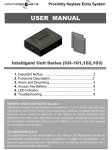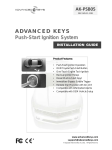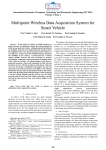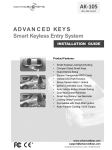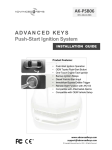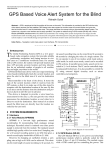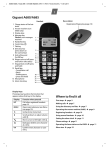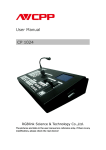Download Review of Various Functions Controlling Of Vehicle by Using Mobile
Transcript
ISSN 2249-6343 International Journal of Computer Technology and Electronics Engineering (IJCTEE) Volume 3, Special Issue, March-April 2013, An ISO 9001: 2008 Certified Journal. E-NSPIRE, A National Level Conference held at Pravara Rural Engineering College, Loni, Maharashtra, INDIA. Review of Various Functions Controlling Of Vehicle by Using Mobile Bluetooth Dipak A. Mhaske, Prof. S.S. Katariya, Prof. S.S. Kadlag Bluetooth technology is no different -- it's wireless and therefore susceptible to spying and remote access, just like Wi-Fi is susceptible if the network isn't secure. With Bluetooth, though, the automatic nature of the connection, which is a huge benefit in terms of time and effort, is also a benefit to people looking to send you data without your permission. Bluetooth offers several security modes, and device manufacturers determine which mode to include in a Bluetooth-enabled gadget. In almost all cases, Bluetooth users can establish "trusted devices" that can exchange data without asking permission. When any other device tries to establish a connection to the user's gadget, the user has to decide to allow it. Service-level security and device-level security work together to protect Bluetooth devices from unauthorized data transmission. Security methods include authorization and identification procedures that limit the use of Bluetooth services to the registered user and require that users make a conscious decision to open a file or accept a data transfer. As long as these measures are enabled on the user's phone or other device, unauthorized access is unlikely. A user can also simply switch his Bluetooth mode to "non-discoverable" and avoid connecting with other Bluetooth devices entirely. If a user makes use of the Bluetooth network primarily for synching devices at home, this might be a good way to avoid any chance of a security breach while in public. Still, early cell-phone virus writers have taken advantage of Bluetooth's automated connection process to send out infected files. However, since most cell phones use a secure Bluetooth connection that requires authorization and authentication before accepting data from an unknown device. [1] Abstract— this paper shows the various functions controlling of Vehicle using mobile Bluetooth Technology. Due to this technology the work of car user becomes easy. This system has two modes of operations viz RKE and PKE mode. This two keys are operated by 89c2051 and 89s52 microcontroller. The functions which are built in system can be handled away from the Vehicle within the range of 10 meters through Mobile Bluetooth. Index Terms—Bluetooth communication, RKE, PKE I. INTRODUCTION The vehicle ignition by using mobile Bluetooth technology will be a great advantage in terms of human energy and time consuming. It is indeed free of charge or no cost involved and can be activated in safe mode since the vehicle still in lock condition. Therefore, in this project an application will be implemented and developed for mobile phone car ignition system by using Bluetooth technology. The system is constructed by integrating both hardware and software. This is an automatic vehicle locking system. In which there are two units one is placed in the vehicle which locks the vehicle if another unit (key) is outside the range. When only the driver or owner of the vehicle is in the range of the vehicle, the vehicle ignition will unlock along with the door and window. The Bluetooth is interfaced with the wires by the ignition switch at the auto starter car alarm remote control, which controls all the main functions in a vehicle. The mobile phone start module basically simulates turning a key in the ignition switch to start the vehicle and keep it running consistently. Whereby, the microprocessor inside the remote auto starter module constantly monitors the engine temperature as well as performance. Therefore, it will be ideally triggered whenever users feel they would like to start their car engine at any time. [5] II. SYSTEM OVERVIEW B. KEYLESS SYSTEM Keyless entry is a standard feature in vehicles that have installed alarm systems. A small battery operated device or remote hangs on the key chain and features one or more buttons for arming and disarming the alarm. The button operates the door locks as well. When one approaches the car, a press of the button will not only disarm the alarm, but unlock the driver's door, making it unnecessary to use a key. Hence, it allows keyless entry. A. BLUETOOTH SECURITY In any wireless networking setup, security is a concern. Devices can easily grab radio waves out of the air, so people Who send sensitive information over a wireless connection need to take precautions to make sure those signals aren't intercepted. Types of Keyless system: 1.Remote keyless system 2.Passive keyless system 48 ISSN 2249-6343 International Journal of Computer Technology and Electronics Engineering (IJCTEE) Volume 3, Special Issue, March-April 2013, An ISO 9001: 2008 Certified Journal. E-NSPIRE, A National Level Conference held at Pravara Rural Engineering College, Loni, Maharashtra, INDIA. A remote keyless system is a system designed to permit or application deny access to premises or automobiles. While the "remote" impact) system is portable and has locking capabilities, the exact Very low (low Medium Power phrase "keyless entry" is solely reserved for the numeric dials Consumption power is a or keypads that are located on or near the driver side door. (Battery option design goal) By entering the correct, pre-determined numeric code, one and life) can gain access to a vehicle without a key - hence the phrase 128 AES plus 64 and 128 bit Security "keyless entry"; entry without a key. In the case of application encyption automobiles an RKS performs the functions of a standard car layer security key without physical contact; power door locks can be locked or unlocked from several feet away or even from inside a Devices can Device Other building. (In this regard, the term "keyless" is a misnomer Information join an existing connection since the fob acts as an electronic key. Locking it in the car is network in requires up to just as much of a problem as doing the same with a under 30ms 10 seconds mechanical key.) [7] [8] [9] Industrial Wireless Typical C. PASSIVE KEYLESS ENTRY SYSTEM Applications control and connectivity A Passive Keyless Entry solution provides the user with the monitoring, between convenience of unlocking a car door without pressing any sensor devices such buttons. The module inside the door initiates communication networks, as phones, by sending out a signal between fixed time intervals to search building PDA, laptops, for the paired Key Fob. Once in the proximity of the car door, automation, headsets the Key Fob sends back an acknowledgment signal. Upon home control positive authentication by the Receiver block, it signals the and car door to be unlocked. [7] [8] [9] automation, toys, games Table No. 1 – Bluetooth Comparison III. SYSTEM BLOCKS Fig.No.1 Bluetooth Range D WHY TO USE BLUETOOTH ZigBee 20, 40, and 250 Data Rate Kbits/s 10-100 meters Range Ad-hoc, peer to Networking Topology peer, star, or mesh Operating Frequency Complexity (Device and Bluetooth 1 Mbits/s 10 meters Ad-hoc, very small networks 868 MHz (Europe) 900-928 MHz (NA), 2.4 GHz (worldwide) 2.4 GHz Low High Fig.No.2 Block Diagram This is an automatic vehicle locking system. In which there are two units one is placed in the vehicle which locks the vehicle if another unit (key) is outside the range. When only 49 ISSN 2249-6343 International Journal of Computer Technology and Electronics Engineering (IJCTEE) Volume 3, Special Issue, March-April 2013, An ISO 9001: 2008 Certified Journal. E-NSPIRE, A National Level Conference held at Pravara Rural Engineering College, Loni, Maharashtra, INDIA. the driver or owner of the vehicle is in the range of the vehicle, discrete rotation of the motor shaft. This is unlike a DC motor the vehicle ignition will unlock along with the door and that exhibits continuous rotation. window. The Bluetooth is interfaced with the wires by the D. Relays ignition switch at the auto starter car alarm remote control, Relays are components which allow a low-power circuit to which controls all the main functions in a vehicle the mobile switch a relatively high current on and off, or to control phone start module basically simulates turning a key in the signals that must be electrically isolated from the controlling ignition switch to start the vehicle and keep it running circuit itself. To make a relay operate, you have to pass a consistently. There is another function used for automated the suitable pull-in and holding current (DC) through its vehicle such as AC function controlling, Fuel Indication, energizing coil. In each case the coil has a resistance which Window & Door locking unlocking through the various will draw the right pull-in and holding currents when it is interfacing devices and circuitry connected to that supply voltage. So the basic idea is to choose a relay with a coil designed to operate from the supply voltage you.re using for your control circuit (and with contacts capable of switching the currents you want to IV. SYSTEM ANALYSIS control), and then provide a suitable relay driver circuit so that your low-power circuitry can control the current through A. Bluetooth the relays coil. Typically this will be around 70ma. Blue LINK is a compact Bluetooth Module ( 5V Serial TTL) from rhydoLABZ. The module has built-in Voltage E. Microcontroller At89c2051. regulator and 3V3 to 5V level converter that can be used to interface with 5V Microcontrollers. The module has only 5 Features: • Compatible with MCS-51™ Products pins (Standard 2.54mm berg strip) VCC, GND, TX, RX and • 2K Bytes of Reprogrammable Flash Memory RESET. The module is factory configured in Transparent • 2.7V to 6V Operating Range Mode and hence there is no command required for normal • Fully Static Operation: 0 Hz to 24 MHz operation. • Two-level Program Memory Lock Features: • 128 x 8-bit Internal RAM Support Master & Slave Mode • 15 Programmable I/O Lines Support UART interface to host system • Two 16-bit Timer/Counters Serial communications @ 2400-115200bps • Six Interrupt Sources Breadboard Compatible • Programmable Serial UART Channel Frequency: 2.4~2.524 GHz • Direct LED Drive Outputs Power Supply: 5V [1] • On-chip Analog Comparator • Low-power Idle and Power-down Modes [4] B. Microcontroller 89s52 : F. Algorithm & Flowchart of Receiver Section Features: 1) Start • Compatible with MCS®-51 Products 2) Iinitialize uart mode • 8K Bytes of In-System Programmable (ISP) Flash Memory 3) Initialize lcd • Fully Static Operation: 0 Hz to 33 MHz 4) Wait for data to be received serially • 256 x 8-bit Internal RAM 5) Is data received= door lck_ulk then COMPLIMET the • 32 Programmable I/O Lines vehicle DOOR LOCK • Three 16-bit Timer/Counters 6) Is data received= ignition lck_ulk then compliment • Eight Interrupt Sources IGNITION ON/OFF • Full Duplex UART Serial Channel [4] 7) If cmd auto received then unlock the door and turn on the ignition C. Stepper Motor 8) Stop Stepper Motor is known by its important property to convert a train of input pulses i.e. a square wave pulses into a precisely defined increment in the shaft position. Each pulse moves the shaft through a fixed angle. A stepper motor is an electrically powered motor that creates rotation from electrical current driven into the motor. Physically, stepper motors can be large but are often small enough to be driven by current on the order of milli ampere. Current pulses are applied to the motor, and this generates 50 ISSN 2249-6343 International Journal of Computer Technology and Electronics Engineering (IJCTEE) Volume 3, Special Issue, March-April 2013, An ISO 9001: 2008 Certified Journal. E-NSPIRE, A National Level Conference held at Pravara Rural Engineering College, Loni, Maharashtra, INDIA. Fig.No.4 Algorithm & Flowchart of Transmitter Section Fig.No.3 Algorithm & Flowchart of Receiver Section G. Algorithm & Flowchart of Transmitter Section 1) Start. 2) Initialize serial port. 3) Wait for switch to be pressed. 4) If switch pressed=door lck_ulk then send door lck_ulk command 5) If switch pressed=ignition lck_ulk then send ignition lck_ulk command 6) If switch pressed=Auto mode then activate the module in auto mode. 7) If switch pressed=Manual mode then activate the module in manual mode. 8) If in auto mode the send auto mode command 9) Go to 3 10) STOP V. CONCLUSION „Bluetooth based vehicle inter lock system‟ is successfully implement & design through this project. We have design & operational various attributes of the vehicle like Ignition locking, Door Locking, Fuel indication, AC function, Window locking through the Bluetooth Device. This projects is feasible for following functions & which are beneficiary of Various control mechanism away from vehicle. Time saving/ Comfortable to user Secured 51 ISSN 2249-6343 International Journal of Computer Technology and Electronics Engineering (IJCTEE) Volume 3, Special Issue, March-April 2013, An ISO 9001: 2008 Certified Journal. E-NSPIRE, A National Level Conference held at Pravara Rural Engineering College, Loni, Maharashtra, INDIA. ACKNOWLEDGMENT Prof. S.S. Katariya has Published 08 papers in International Journal, 02 papers in National Journal & presented 04 papers in International Conference & 13 papers in National Conferences. I take this opportunity to acknowledge a deep sense of gratitude to my seminar guide Prof. Katariya S.S. who made this entire work possible and without whose invaluable guidance this seminar paper could not have been completed. I am also thankful to the staff of the library for providing the necessary books, magazines for collecting the information related to the project. At last, but not the least, I would like to thank all my colleagues for providing help in my work. Prof. Kadlag S. S. has completed his M.E.(Electrical, Control System) & B.E. (Electrical Electronics & Power), Member of ISTE. He is working as a Associate Professor in Electrical Department as Head Of Department, Amrutvahini College Of Engineering, Sangamner, Dist. Ahmednagar, Maharashtra, India. Prof Kadlag has teaching experience of 14 years to Undergraduate, Graduate Students and also has 3 years Industrial experience. REFERENCES [1] A7 Engineering Inc. “Embedded Blue 506 User Manual,”, 2005. Prof. Kadlag S. S. has Published 02 papers in International Journal, 05 papers in National Journal & presented 02 papers Conference. [2] Jamilah Karim,Wan Mohd Arman Bin Wan Amat and Abdul Hadi Abdul Razak, “Car ignition system via mobile phone,” IEEE, vol. 5189828, August 2009, pp. 474-476, ieeexplore/ arnumber. 518982 [3] Kamal Hyder, Bob Perrin, “Embedded Systems Design using the Rabbit 3000 Microprocessor (Interfacing, Networking, and Application Development)”, Elsevier Inc, 2005. [4] Muhammad Ali Mazidi, Janice Gillispie Mazidi, Rolin D. Mckinlay “The 8051 Microcontroller and Embedded System” Using Assembly and C. [5] Mobile Phone Car Ignition System Using Embeded Blue 506 Bluetooth Technology, 2011 IEEE Control and System Graduate Research Colloquium [6] http://www.advancedkeys.com/technology.htm [7] http://www.maxim-ic.com/app-notes/index.mvp/id/3395/CMP /WP-19 [8] http://en.wikipedia.org/wiki/Remote_keyless_system [9] http://auto.howstuffworks.com/remote-entry.htm [10] http://www.wisegeek.com/what-is-keyless-entry.htm Author’s Profile Mr. Dipak A. Mhaske has completed his B.E. (Electronics) & currently appear to M.E. (Electronics) in Amrutvahini College of Engineering, Sangamner. Dist.- Ahmednagar, Maharashtra, India. He is working as Lecturer in Electronics Department, Pravara Rural Engineering College, Loni, Maharashtra, India. Prof. Shraddha S. Katariya (Patni), has completed her M.E.(Electronics) & B.E. (E& TC), Member of IEEE & ISTE. She is working as a Assistant Professor in Electronics Department, Amrutvahini College Of Engineering, Sangamner, Dist. Ahmednagar, Maharashtra, India. Prof Katariya has teaching experience of 14 years to Undergraduate, Graduate & Post Graduate Students. 52





